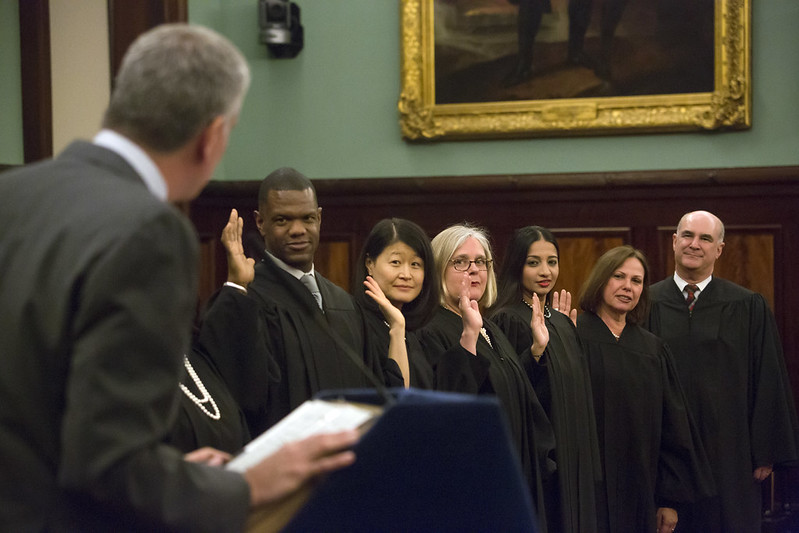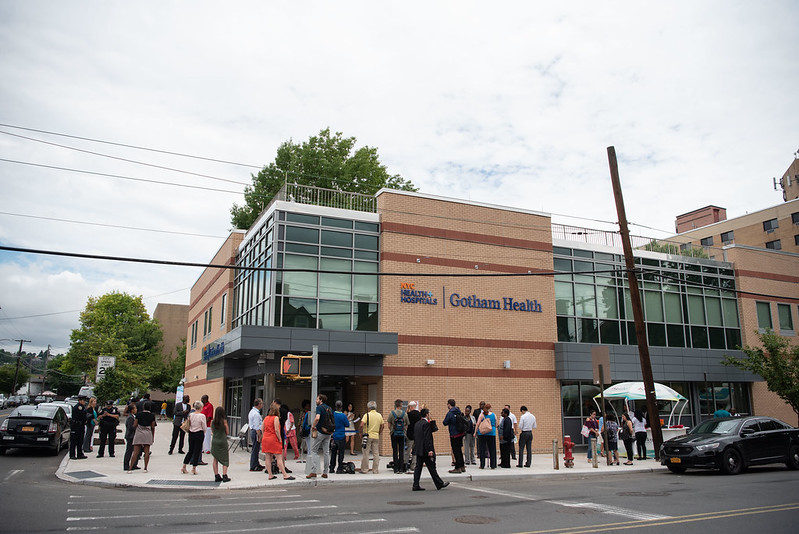It’s Time to Reform New York’s Judicial Selection Process

Judicial oath of office (photo: Ed Reed/Mayoral Photography Office)
I recently wrote an op-ed on the need to raise public awareness about judicial selection, inspired by the leak of the Supreme Court draft opinion in Dobbs that would reverse Roe and the recognition of women’s reproductive autonomy. As a candidate for Surrogate’s Court Judge, I have been frequently asked about the judicial selection process and hope to advance an open dialogue on judicial reform, independence and the importance of voter awareness.
Anecdotally, according to my own recent informal Twitter poll, a plurality prefers that judges are elected as opposed to appointed, or a combination thereof. But New Yorkers clearly need a better understanding of the process.
Judicial selection methods in New York State can be particularly baffling. Some judges are appointed (by the Mayor or Governor), some are elected, and some are “elected” without direct voter participation.
For example, candidates for state Supreme Court judge appear on the ballot through a process that is little known and poorly understood by most people. New York's Election Law (§ 6-124) created an alternate method to the petitioning process. In place of a primary election, judicial delegates (who are elected during the Democratic primary) vote at a judicial nominating convention (usually in late summer) for the Democratic Party candidates who will appear on the general election ballot. This process not only deprives the voting public the opportunity to directly participate, but it can be fraught with issues of conventional party politics; namely who’s in the know and in control.
In contrast, judicial candidates for other positions must petition for a specified number of signatures from registered voters of their party to appear on the primary ballot. I am running for Manhattan’s Surrogate’s Court, also known as probate court, the court that oversees wills and estates, as well as the appointment of fiduciaries, guardianships, and adoptions. For a countywide side seat, I was required to obtain 4,000 signatures from registered Democrats to appear on the primary ballot. However, as a practical matter, a candidate must obtain triple the number of required signatures to withstand a potential challenge by a competitor. The process is made arduous because of the limited time frame to obtain signatures (about a month).
Judicial candidates for Civil Court positions also need signatures (1,500) to appear on the primary ballot, a threshold significantly higher than required in races for Congress (1,250), State Senate (900), State Assembly (500) and City Council (450).
An additional incongruity is that Civil Court districts - established in 1962 by state law - are not subject to redistricting laws or the federal Voting Rights Act, so their lines remain static notwithstanding population shifts. Despite the recent focus in New York on gerrymandering and the fairness of districts, judicial lines were absent from the discussion.
In Manhattan, district leaders (or “state committee members”), also elected but with few specified legal duties, play a significant role in the promotion of judicial candidates. It’s a lot to ask of voters to find information on these less commonly known seats (judicial delegates, and state and county committee leaders), and research their stance on the judiciary prior to primary day. However, until the system is reformed, these positions continue to play an outsized part in the outcome of judicial races, and voters should at least understand that judicial selection depends on the role these “go-betweens” serve.This is particularly the case as voters rely on the independence of the judiciary, whose impactful decisions are felt first-hand by the electorate.
We need real electoral reform in judicial elections.
Some suggestions include a reduction in the number of required nominating signatures, a cap on the amount that can be spent on judicial races (with strict donation limits), and a re-examination of the function of judicial delegates, district leaders, and judicial districts that have witnessed population shifts.
There is nothing wrong with voters choosing who their judges are. The problem is that voters lack the information necessary to make informed choices. In a society always striving for improvement and reform, the judicial selection process should not be last in line.
***
Elba Rose Galvan is a Surrogate's Court Referee in King's County and candidate for Manhattan Surrogate. She served under Surrogate Margarita Lopes Torrez, and currently serves under Surrogate Rosemarie Montalbano, both considered reformers of the court.
***
Have an op-ed idea or submission for Gotham Gazette? Email This email address is being protected from spambots. You need JavaScript enabled to view it.
As Albany Continues to Abandon Homeless New Yorkers, California Considers New Solutions

Health and housing are tied (photo: Michael Appleton/Mayoral Photography Office)
As roughly 50,000 men, women and children sleep in a New York City homeless shelter each night and the number of people living unsheltered on the streets and subways has increased, the powers that be in Albany bear a large portion of the responsibility for the current state of affairs. It is time that we take a long hard look at what state government has done in this regard instead of putting all the blame on City Hall.
According to the very comprehensive State of the Homeless report published annually by the Coalition for the Homeless, the state government continues, as it has for many years, to receive failing grades on almost every metric. With regard to meeting the needs of unsheltered New Yorkers, New York State received a failing grade on five of the six metrics and a “D-” on the other one. In addition it received similar grades on the operation of the shelter system, housing, and institutional discharge planning.
On this last category, each year since 2015 more than 40% of people released from state prisons to New York City were released directly to shelters. This amounted to an average of about 3,500 a year. As Gotham Gazette recently reported, little is being done to help those leaving prison find stable housing, and so many wind up going directly into the shelter system, with some then leaving for the streets.
The homelessness crisis is being seen more and more as a mental health crisis, which it is in part, and once again New York State bears a heavy responsibility for what we now see. The state psychiatric center system that once served 93,000 New Yorkers has now dwindled to an insufficient 2,330 beds.
Meanwhile, nothing paints a better picture of how state government has abandoned homeless New Yorkers than how the shelters are funded. As the cost of New York City Department of Homeless Services shelters rose by nearly $1.2 billion between fiscal years 2011 and 2021, the city was left to pick up 95% of the increase for single adult shelters and 32% of the increase for family shelters. While the state covered a mere 4% of the additional cost for single adult shelters and 7% for family shelters.
The new state budget is somewhat better but far from acceptable. Lawmakers passed a budget that does little to house homeless New Yorkers, according to exasperated advocates and policymakers. “It’s pretty dreadful,” said Legal Aid Society Supervising Attorney Judith Goldiner.
During protracted negotiations, the governor and legislators axed a proposed Section 8-style rent subsidy for New Yorkers experiencing or at-risk of homelessness. Governor Kathy Hochul and her budget team said it was too expensive.
While New York City and State are facing this monumental task of substantially reducing homelessness they must be equal partners. In California, which is also facing a homelessness crisis, a new approach has emerged.
California has a new plan to get people off the streets and into treatment. CARE (Community Assistance Recovery and Empowerment) Courts connect a person in crisis with a court-ordered Care Plan for up to 12 months, with the possibility to extend for an additional 12 months. The framework provides individuals with a clinically-appropriate, community-based set of services and supports that are culturally- and linguistically-competent. This includes short-term stabilization medications, wellness and recovery supports, and connection to social services, including housing.
CARE Court is not for everyone experiencing homelessness or mental illness; rather it focuses on people with schizophrenia spectrum or other psychotic disorders who lack medical decision-making capacity – before they get arrested and committed to a state hospital.
Although homelessness has many faces in California and New York, among the most tragic is the face of the sickest who suffer from treatable mental health conditions — this proposal aims to connect these individuals to effective treatment and support, mapping a path to long-term recovery.
CARE Court may help thousands on their journey to sustained wellness. Its engagement begins with a petition to the court from a wider range of individuals, including care providers, family members, first responders, or counties, among others. CARE Court may be an appropriate next step after a short-term involuntary hospital hold.
Having served as a Deputy Commissioner in the New York City Department of Homeless Services and as a Vice President for Supportive Housing for a nonprofit, I know it is easy to get caught up handling the day-to-day crises which arise in a system that spends more than $3 billion a year. However, we must set aside time and staff to explore the big picture as California is doing.
***
Robert Mascali is a former Deputy Commissioner at the NYC Department of Homeless Services and a former Vice President for Supportive Housing at Women in Need.
***
Have an op-ed idea or submission for Gotham Gazette? Email This email address is being protected from spambots. You need JavaScript enabled to view it.
Key Investments New York City Needs to Make in CUNY This Budget

CUNY graduation (photo: CUNY)
Since the start of the pandemic, CUNY students have witnessed trauma every day. They’ve mourned loved ones who died. They’ve struggled with testing and vaccine availability. They’ve borne the stress of the COVID-19 economic crisis, and braved the worst outbreaks as front-line workers to help their families survive.
Unsurprisingly, CUNY’s enrollment declined beginning in March 2020. It’s struggled to rebound, especially at the community colleges where many students come to campus from the neighborhoods hardest hit by COVID-19.
Community college students have always struggled to balance life and a life-changing education. Community colleges around the country face the persistent challenge of retaining students through to graduation. With the increased attention on enrollment this year, now is the time to move toward a solution by investing in the wraparound services that make it possible for CUNY students to return to and stay on campus.
City Council Speaker Adrienne Adams’ recently announced CUNY Reconnect Initiative wisely offers the funding needed to support the services we know work to ensure students remain enrolled and engaged. The initiative would invest $23 million in CUNY and should be supported by the Mayor and full City Council in this year’s budget negotiations.
According to the Center for an Urban Future, there are nearly 700,000 working-age New Yorkers with some college credits but no degree. As a result, the jobs that create a pathway out of poverty and sustain families are often beyond their reach. On average, Americans with college degrees earn 65% more income per week than workers without degrees. CUNY Reconnect would help give working age New Yorkers with some college credits another chance at a great education.
The program emphasizes the need for increased services to help struggling students navigate the college environment. A similar program in Tennessee invested in child care, pre-enrollment counseling, and other services. CUNY is poised to provide such support. But the proposed investment is only a start.
The Speaker’s initial request for $23 million is a laudable beginning but we must go further. CUNY Reconnect can work, while serving existing students, if we make additional investments in the services that are proven to boost graduation and retention rates. One such service is ASAP, the Accelerated Study in Associate Programs Initiative.
ASAP is known as the most successful program at CUNY’s community colleges and modeled around the country in part because it gives students access to a dedicated advisor from enrollment to graduation. Multiple studies show that improved advising increases graduation rates. More funding must be included to increase access to academic advising at CUNY.
Since COVID-19, the increased need for advisors has created an unprecedented backlog. As Academic Advising Director in the Department of Africana Studies at John Jay, I saw the huge increase in numbers of students that needed guidance as we switched back from virtual to in-person learning. And now I see the urgent need for more thorough advisement among students returning to their studies after taking a break during the pandemic. An astonishing 44% of CUNY students are first-generation college students. They depend on advisors to help them navigate a system that can seem byzantine to an outsider. When acclimating to the new and unfamiliar space of college, advisors are their lifeline.
CUNY advisors want to help, but we’re struggling. At a recent union gathering one advisor called the student-to-advisor ratio “mental and emotional murder.” Another noted that “it’s very difficult to do case management because those caseloads are so high… [we are] losing staff members. We are all exhausted.” The current situation is not sustainable and doesn’t give our students what they deserve.
We can do better. CUNY is a public service and a wise investment. In this year’s budget, the City must step up for its people. This year’s New York City budget must expand funding for advising CUNY-wide so that all students can receive the level of high-contact individual attention offered via ASAP. And for good reason: the three-year graduation rate for ASAP students is more than double that of non-ASAP associate degree students at CUNY’s community colleges and it narrows graduation gaps for Black and Hispanic males. A move toward ASAP for All is a $20 million investment that would provide more students with the advisor they deserve.
CUNY students want to graduate, taking their new skills and diploma into the next stage of their lives. The City wants that too. It can’t happen without the wrap-around services students need to navigate college.
***
Rulisa Galloway-Perry is Academic Advising Director and Administrator at John Jay College.
***
Have an op-ed idea or submission for Gotham Gazette? Email This email address is being protected from spambots. You need JavaScript enabled to view it.




